Abstract
Collective memory is a specific carrier for interpreting historical space and local emotions. With the help of collective memory theory, this paper constructs the industrial heritage system of an old industrial zone. Taking the old industrial area in Jianxi District of Luoyang as an example, this paper uses two types of memory representations, the material memory field and spiritual memory field, as the carriers of collective memory. It is divided into 11 types of spatial fields, such as production space, living space, landscape space and spiritual culture, and 76 memory connotations to construct a collective memory classification model of industrial culture. Through the investigation and analysis of the memory of the collective memory subject, it was found that: ① the collective production space is the most impressive. ② The living space is distributed in patches due to celebrity effects; and ③ People are more prominent in the symbolization of collective memory. On the foundations of memory analysis, Take the luoyang bearing factory for example, to research the sustainable development of intelligent and energy-efficient buildings.
1. Research Background
At present, the level of urbanization in China has exceeded 60%, and urbanization has also entered the middle and later stages; most cities have changed from incremental to stock development, and people are becoming more aware of the importance of historical environmental protection. At the beginning of 2021, it was pointed out in the National 14th Five-Year Development Plan that the old industrial area is an important part of urban renewal. In the “Revitalization and Development Plan for Special types of areas of the 14th five-year Plan” approved by the State Council on 26 November, it was proposed to carry out the interpretation and display of the value of industrial heritage [1], carry forward the contemporary value of industrial heritage and promote the transformation and upgrading of old industrial areas. In 2015, the members of the United Nations also adopted the 2030 Agenda for Sustainable Development and its Sustainable Development Goals (SDGs). In the process of urbanization in the past few decades, a large number of industrial cultural heritages have been impacted by urban renewal. The urban pattern is constantly being eroded, and the urban memory that once could be seen everywhere every day has been abandoned in the rapidly developing society. However, in many cities, as the unit composition of the city, the old industrial zone is not only the foundation and carrier of the society but also plays the role of the connection and link between the society and the individual. It is also a microcosm of an urban society, which can truly record and reflect the historical changes and development track of the society both statically and dynamically, and it is the collective memory of the regional social community.
2. Tracing to the Source of Collective Memory
Memory first appeared in the myths of Mnemosyne, the goddess of memory, in ancient Greece. The concept of “mnemonics” was first put forward by Simonides [2] in ancient Greece, which is used to improve the ability to recall events that are related to the spatial environment and correspond to concrete things. There are many forms of memory. Edward Said believes that there are many forms of “collective memory”, “urban memory”, “social memory”, “public memory”, “historical memory”, “personal memory” and “cultural memory”. Lily Kong pointed out that personal memories are often cluttered, fragmented and highly subjective. Although personal memories are embedded in ordinary people and their daily affairs, they play a key role in the establishment of relationships between people and places. The concept of “collective memory” was first put forward by French sociologist Hubvach in 1925 to refer to individual memory and its social origins, and it was defined as “the process and result of sharing past events among members of a particular social group” [3,4,5].
Lewis Mumford, an urban historian, believes that cities exist in memory. Kevin Lynch summed up the five elements of the city image—roads, boundaries, regions, nodes and landmarks [6]. Italian architect Aldo Rossi put forward “Urban Collective memory” to explore the destruction and neglect of the city as people’s collective memory [7,8]. It calls on designers to endow urban space and place spirit and humanistic atmosphere through collective memory, so that people can directly experience the connection with history. Colin Rowe put forward the concept of a “collage city”, emphasizing the interpretation of the urban spatial form and the continuation of urban context by history and culture through the dimension of time [9,10,11].
According to the research of domestic scholars on the historical protection and renewal of “memory”, Wang Jianguo believes that part of the vitality of the city comes from people who share a common vision, usually those self-sufficient within the social circle of acquaintances, social groups with similar or even common experiences and common collective memories. From the perspective of built heritage, Chang Qing expounds that the archetypal image contained in the city is a lingering source of value, and the built heritage should become a unique driving force for economic and social development and cultural revival [12,13]. Huang Minghua believes that through the time dimension, it emphasizes the cultural diversity of architectural space with different cultural backgrounds in different periods and forms the space of collective memory. Xu Subin believes that “urban memory and industrial heritage” is directly related to the “memory field” and “topophilia”. Lu Fei selected the “156 projects” in Harbin as the research object, combed its material relics in detail from the two aspects of a spatial model and architectural characteristics and put forward the renewal strategy [14,15,16,17].
Generally speaking, scholars mostly focus on the protection practice of historical landscape architecture and historic cities under the guidance of the “top-down” elite’s place memory and urban memory. There is little discussion on the memory protection and renewal of the old industrial area which emphasizes the bottom-up “collective memory”, and there is a lack of attention on the construction of the place to feel by the citizens the destination of nostalgia and public participation. This study constructs the collective memory classification model of the old industrial area, in the form of a questionnaire, from the point of view of the residents’ collective perception memory, studies the characteristic environment of the old industrial area and puts forward the renewal strategy and method.
The collective image formed by collective memory is not only the reflection of subjective consciousness but also the objective existence, so memory is biased, selective and dynamic. The interaction between urban development and collective memory shapes the local cultural characteristics and forms the collective memory of regional identity [18,19,20]. Based on the concept of Habvach, and combined with the understanding of relevant psychological categories and urban architectural landscape categories, the connotation framework of “collective memory” is constructed (Figure 1). The connotation of collective memory is integrated into Jianxi District of Luoyang for specific research. Most of the collective memories we know are based on the national or ethnic level. The collective memory studied here is slightly different from the general cognition. It not only emphasizes the national level but also pays attention to the local collective memory, focusing on the collective memory of a specific geographical space to create a characteristic environment for the renewal of the old industrial zone [21,22].
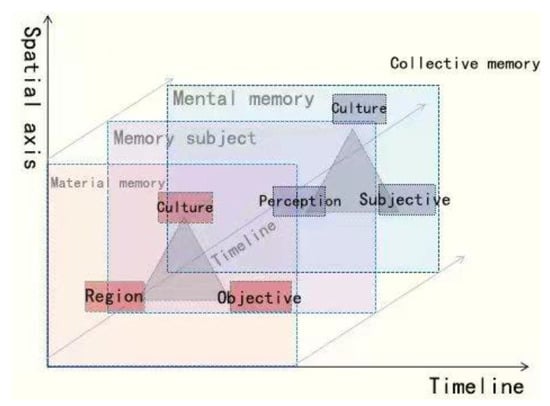
Figure 1.
Collective memory connotation frame. Picture Source: painted by the author.
Based on the definition and scope of industrial heritage and the analysis of the elements of industrial heritage planning in documents such as The Nizhny Tagil Charter for the Industrial Heritage, Wuxi Declaration and Guidelines for the Preparation of Planning for the Protection and Utilization of Industrial Heritage in Old Industrial Areas, Lu Jiwei, Li Wei, Zhou Wei, Kong Xiang, Lu Fei and other scholars evaluated the elements of memory based on the literature. The connotation framework of collective memory is integrated into the old industrial area for specific research, and the research model of collective memory in the old industrial base is built.
3. Research Areas and Methods
3.1. Research Areas
The seven industrial projects of Jianxi’s old industrial zone in Luoyang (first tractor factory, CITIC-mine machinery factory, bearing factory, refractory factory, copper processing plant, thermal power plant and diesel engine plant), with a population of about 650,000, belong to the first five-year Plan period in the early days of the founding of the people’s Republic of China. The “156 projects”, which were built with the assistance of the Soviet Union, are regarded as the cornerstone of New China’s industry. The related research in Jianxi District is slightly different from the old industrial zones in other cities. There are seven large factories in succession, with overall construction of large scale and magnificent momentum. Jianxi District has about 1531.71 hectares of land, with 742.85 hectares of industrial land, accounting for 48% of the total land, most of which is M3 (740.25 hectares), which stretches for 5.7 km along Jianshe Road. The factory area, neighborhood area and scientific research units are regularly distributed along the road. Life, culture and entertainment are interspersed among them, with a symmetrical layout and obvious characteristics. The planning pattern of the famous Luoyang Model written in the planning textbook is intact. Jianxi District was one of the most concentrated industrial zones in China at that time. The Jianxi old industrial zone is a historical witness of the road to industrial power in New China, which has important historical, scientific, artistic and social emotional value. The study focused on the collective memory of the material memory field and mental memory field of the seven old industrial areas in the form of a questionnaire.
3.2. Research Methods
The questionnaire is based on historical data and a qualitative study. Collected a large number of graphic materials reflecting different development stages of Jianxi District, such as pre-construction maps, factory records, newspapers, old photos; excavated the collective memory elements of its storage; and explored the correlation effect between its spatial evolution and collective memory. Got in touch with Luoyang Archives Bureau, Luoyang Architectural Planning and Design Research Institute, Luoyang Tourism Bureau, Jianxi District and other departments to collect relevant historical picture and text materials. The following hypotheses were then tested in turn: (1) the residents have formed a collective memory of the once brilliant industrial culture and deeds of Jianxi District; (2) the representative production and life fields such as the statue of Chairman Mao in front of the door and neighborhood No. 2 are effective material carriers for carrying collective memory; and (3) anecdotes of celebrities such as Xi Zhongxun and Jiao Yulu and the “cradle of major equipment of the Republic” are effective spiritual carriers for carrying collective memory. The study is based on the connotative elements of more than 70 items in 11 categories (Figure 2), including the material memory field and spiritual memory field, productive spatial memory, living spatial memory and so on [23,24,25,26,27,28,29,30,31,32,33,34].
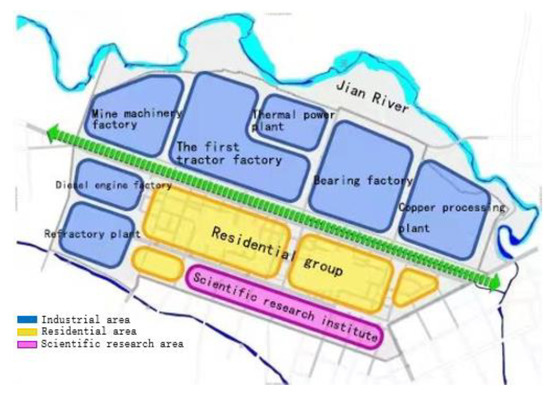
Figure 2.
Research area and object. Picture Source: painted by the author.
The biased statements measured the memory familiarity of the interviewees. In addition, the respondents’ access to memory and their preference for updated style were also investigated. The survey asked respondents if they know the statement, with a score of 1–5, ranging from “very familiar” to “not knowing”. In the mental memory field survey, the respondents were asked to state whether they had an impression or not, which was divided into three levels: impression, ambiguity and non-impression. The questionnaire survey was conducted in the residential areas around the factory from 7 to 10 April 2019 and 11 to 14 March 2021, and some household surveys were carried out. In order to obtain detailed information of the respondents’ collective memory, the 2020.10–12 survey also included semi-in-depth interviews with 18 elderly residents and in-depth interviews with 5 residents. The focus was on the glorious memories of each enterprise’s history. The 10 family members who entered the household mainly paid more attention to the intention of renewal and transformation and so on. There are 150 questionnaires on 21 aspects, such as age, occupation, the towing factory, copper processing factory, bearing factory, mining machinery factory, “156 project” in Jianxi, historical district, celebrity anecdotes and brand culture of the Luoyang model (Figure 3).
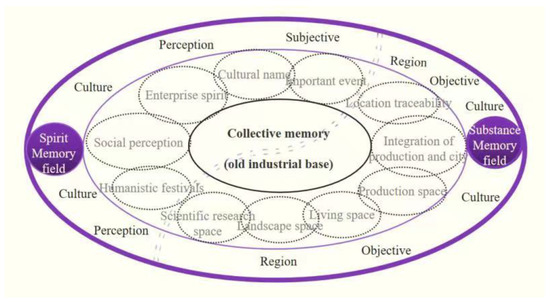
Figure 3.
Research model of collective memory in old industrial base. Picture Source: painted by the author.
4. Analysis of Survey Results
Among the 116 valid samples collected, the gender of the residents interviewed is basically symmetrical, mainly middle-aged and elderly (66% are over 45 years old), mainly factory workers and company employees (53%) and those who have lived in the local area for more than 6 years (76%). Those with high school education or above accounted for 85%, and those with higher education accounted for 47%, which was consistent with the knowledge-intensive industrial structure of Jianxi District. The survey shows that the degree of memory of material memory and mental memory is quite different because of the difference in age and occupation.
4.1. The Influence of Material Memory Field on Memory Collective
4.1.1. The Influence of Productive Place on Collective Memory
The questionnaire survey shows that the physical space carrier in Jianxi District has a great influence on collective memory, and the memory degree of productive places from high to low is the first tractor factory, mining machine factory, bearing factory and copper processing factory. The industrial production space produces a deeper memory for residents (familiarity and familiarity account for 82%, with an average memory of 4.5). The memory degree of “First tractor” is the highest, and the lowest of the diesel engine factory is 2.7. The huge statue of Chairman Mao in front of the factory forms the highest collective memory (average familiarity around 4.9). The grand and romantic garden-style factory area fully embodies the characteristics of the industrial factory area during the socialist planned economy period. The seven large factory production sites together with the statue of Chairman Mao constitute the symbol of Jianxi District. In the interview (male, 52 years old, Director Xie, Director of Industry and Information Bureau), speaking of the old industry in Jianxi District, it was said that its profound historical accumulation has filled many gaps in China’s industrial history, created a number of firsts and made great contributions to “made in China” and “created in China”. The production space of each large factory, in addition to the factory workers, are familiar with, generally, “idle people are not allowed to enter”, so outsiders are very strange, having almost not been there. Because the closed management of the factory is exclusive, it is relatively strange. The survey shows that the local people are full of pride of the old industry in Jianxi, and the residents have a deep memory of the statue of Chairman Mao at the gate of the Luoxian factory. This plays a role in spiritual cohesion.
4.1.2. The Influence of Living Place on Collective Memory
The survey shows that the life groups represented by the No. 2, No. 10 and No. 11 neighborhoods play an important role in the formation of collective memory. An average of 81% of the residents surveyed (with a memory of 4.92) said they knew that No. 2, No. 10 and No. 11 were Su’s buildings, which should be because the living area of the neighborhood was closely related to the lives of the residents, and each neighborhood had “National Historic District” signage at the front. Public participation is high (memory is 4.91). The neighborhoods in the living area carry the memories of more than 100,000 workers, and they are also the place where the older generation of revolutionaries and Soviet experts lived and studied. Most of the residents interviewed (female, 65-year-old Yan Fen) said they liked the neighborhood relations and strong living atmosphere there: “in those days (1980s and 1990s), the Shanghai market was the most fashionable and fashionable place in western Henan. If you look good, you will say that you bought it in the Shanghai market.” The survey shows that the Shanghai market and Guangzhou market have high memory and identity, with 4.0 and 3.8, respectively. The Shanghai and Guangzhou markets were the entertainment and leisure shopping centers in Jianxi District at that time, they becoming regional fashion centers because of their fashion and high-end nature (Figure 4).
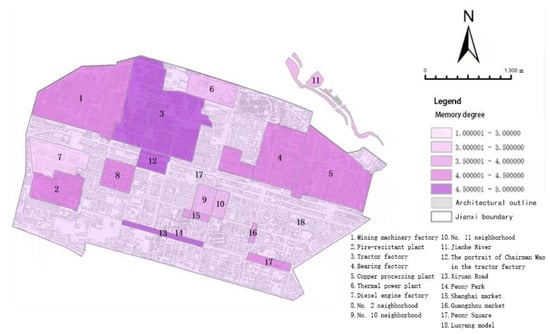
Figure 4.
Interpolation analysis of material memory in Jianxi. Picture Source: painted by the author.
4.1.3. Influence of Scientific Research Space Field on Collective Memory
The survey shows that members of the public are not very clear about the names of the scientific research institutes on Xiyuan Road, but the average value of their knowledge is 3.35. It is generally believed that the scientific research space has higher requirements for academic qualifications and majors, and the degree of collective memory should be relatively low. However, Xiyuan Road is an educational and scientific research area, which is set up in supporting industrial production areas. There are 13 scientific research institutes, such as the Fire Refractory Research Institute, Axial Research Institute and Nonferrous Metal Design Institute, and 2 universities. At the beginning of the founding of the people’s Republic of China, the density of qualified personnel in Jianxi District is second only to Silicon Valley in Haidian District, which undertakes regional R & D and innovation work, and a lot of high technology comes from there. The interviewees (female, 45-year-old Wang Xiaoyan) said that this is the gathering highland of the best units in Luoyang, and the object of envy, she said: “when I was a child, when I heard about working in Jianxi Design Institute and No. 6 Research Institute, they all felt very envious and mysterious. I think it is a representative of knowledge and culture, and in today’s words, it is high-end, so the degree of collective memory is relatively high.
4.1.4. Influence of Natural Landscape on Memory
The present situation of the natural resources in Jianxi District is good, with a zonal distribution as a whole and a series of open spaces and affiliated green spaces. The boulevard composed of the magnificent Fatong of Xiyuan Road is beautiful and pleasant and is loved by the public. The survey shows that the degree of familiarity is more than 3.8, and the score is the highest in landscape memory. Xiyuan Road was the most beautiful road in Luoyang at that time. This was due to the tall Indus trees, first, because Xiyuan Road was a model road in Luoyang at that time, and second, Xiyuan Road was geographically connected with scientific research institutes and the Shanghai market. It was also the center of life, leisure and entertainment. Daming Canal, as a green isolation belt in the former Soviet Union aid period, is now partially covered, but the whole canal still has the potential for restoration and transformation, with the lowest memory of 2.01. Jianhe belongs to the industrial rust belt and is located on the west-north side of Jianxi District, which is an important part of the whole Luoyang green space system. The name of Jianxi is named for being located west of Jianhe River, and the memory in the survey is 3.81. Thousands of peonies are planted in Peony Square, carrying the good times of the citizens, with a memory of 3.91. It is a good place for citizens to relax and entertain.
4.2. The Influence of Mental Memory Field on Collective Memory
The questionnaire shows that people’s memories of celebrities and important events in the old industrial base of Jianxi District can be divided into three levels: impression, ambiguity and non-impression.
4.2.1. Cultural Name and Enterprise Spirit
82% of them have the impression of 156 projects belonging to the major factories, and the highest impression of the collective memory of the enterprise brand is 52% (the “Dongfanghong” brand of the first tractor factory). A deeper understanding of the enterprise, such as the name part of the “impression”, the name of the Republic equipment industry “eldest son”, accounted for 34; Luo Tong’s name: the vanguard of the non-ferrous metal industry was impressed by 19 people (Table 1). The name of Luo axis: Havalo, one of the three major bases of China’s bearing industry, has 62 people; Luo Mine is impressed as “the backbone of Chinese industry and the cradle of major equipment,” and there are 22 people. The interviewees (female, Ms. Li, 42) only know that the old industrial base in Jianxi is very powerful, but I can’t say exactly what it is. The connotation of spiritual memory requires interviewees to have a deeper understanding of corporate spirit and culture, which is a small-scale collective memory. Therefore, the degree of memory is much weaker than the intuitive aspect of material memory. The old industrial base in Jianxi District of Luoyang has created many firsts in the industrial history of the Republic and filled in many gaps. Jianxi District has created a brilliant industrial civilization in the construction of ups and downs in the past 70 years. It has precious spiritual wealth. Protection and inheritance should be strengthened. It requires a high degree of the unity of matter and spirit in collective memory.

Table 1.
Mental memory analysis of mine machine factory and tractor factory. Self-made by the author.
4.2.2. Social Perception
According to the investigation and analysis, Jiao Yulu, Xi Zhongxun and Ji Dengkui, the revolutionaries of the older generation, all worked and studied here, and 29 (25.89%) people were impressed. The old industrial base has received the attention and care of Zhou Enlai, Liu Shaoqi, Deng Xiaoping, Xi Jinping and other party and state leaders. All previous state leaders have inspected and directed the work of the old industrial base in Jianxi (an average of 25.31%). Jiao Yulu has the highest memory; Liang Jun, the female tractor driver, has the lowest memory (the character prototype of One yuan RMB); and the residents with the lowest memory know even less than five people (Figure 5).
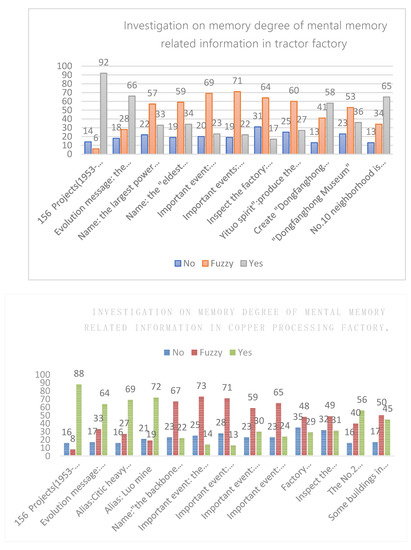
Figure 5.
Investigation on memory degree of mental memory-related information in tractor factory and copper processing factory.
4.2.3. Important Events and Humanities Programs
A total of 19 people in the copper processing factory made the plaque of the “Chinese people’s Revolutionary military museum”, and 14 people in the refractory factory produced the first 2.5 m double-drum winch. Because of the need to have a deep understanding of industrial culture, the first tractor factory made an important contribution to the construction of “agriculture, rural areas and farmers” in China. In total, 22 respondents were “impressed” by the birthplace of the first domestic tractor; So relatively few are impressed.
4.3. The Degree of Collective Memory Elements in Jianxi District under Different Types
Taking the material memory field and the spiritual memory field as the carriers, the industrial collective memory in Jianxi District is divided into 11 categories, such as the production space, living space, landscape space and spiritual culture. According to the investigation degree of collective memory, the physical memory field can be found in 41 places. The memory degree of residents is higher, with an average of more than 4.0, and the collective industrial production space represented by Yituo is the most impressive and area-like distribution. The living space is patchily distributed by the celebrity effect, and the living space with high memory is concentrated in the neighborhoods Nos. 2, 10 and 11 of the historical and cultural districts, as well as the Shanghai market and Guangzhou market, which are highly related to people’s life. Xiyuan West Road has a higher memory degree of landscape space. There are about 25 items for the mental memory field (Table 2). Compared with the places of material memory, people’s symbolization of collective memory is becoming more and more serious, and only the “156 Project” and “Soviet Union-aided Construction” have a higher degree of memory. The connotation of industrial culture, such as celebrities, names and important events, is ignored as the overall memory is not strong (the average impression is only 40%); part of the collective memory of spiritual consciousness, such as important events as a whole, is no more than 25%; and the overall fuzzy state, the professional “Luoyang model”, is about 5%, knowing very little, which is not conducive to the protection of culture and the establishment of cultural self-confidence. Further publicity is needed.

Table 2.
Luoyang Jianxi collective memory structure table. Self-made by the author.
5. The Predicament of Existing Memory in Jianxi District
The products of Jianxi District are mainly large-scale heavy industrial products; the direct purchase of products is not strong, and the participation in the production process is not strong. Due to the existence of technical secrets in some units, the development of experiential tourism needs to find another way. Since the 1980s, the old industry in Luoyang has been facing the test of reform. Because enterprises have successfully implemented the transformation of the management mechanism and carried out enterprise reengineering, they still play a role in the national economy. However, the reconstruction and destruction of historical industrial buildings by “modernization” is becoming more and more serious: on the construction road, some of the factory buildings of the Luoyang mine factory and bearing factory have been converted into high-rise residential buildings; most of the 36 neighborhoods built in the Luoyang industrial zone during the “first five-year Plan” period have been transformed and rebuilt, and there are not many neighborhoods that have completely preserved their original appearance. The green belt between Zhongzhou Road and Construction Road has also been basically fully developed and built. At present, a small number of enterprises are still in operation, the interior of the production plant basically maintains the original style and the Soviet-style architecture is obvious, but the aging is serious. A total of 82% of the people in the survey area strongly believe that this is an indelible memory of Luoyang for the retention and continuation of industrial culture.
5.1. Lack of Memory Data
At present, there is a lack of a systematic survey of the “156 projects” in Jianxi District due to the fact that nearly 1% of the military enterprises have been in a state of secrecy for a long time, and the related civilian projects are also in a state of semi-secrecy. There are also reasons that do not pay enough attention to industrial culture-related materials, which have not been well preserved, showing characteristics of being “unable to remember”. Among the seven projects in Luoyang, only the first tractor factory, the mine machinery factory, the copper processing plant and the bearing factory are relatively detailed. The official websites and sporadic articles of each factory are inconsistent, and some of them are missing.
5.2. The Fault of Collective Memory
According to the survey, the industrial memory of the “156 projects” in Luoyang is weak, and the “deliberate forgetting” of the crowd aggravates the collective memory gap: nine of the “top-down” government departments lack understanding of the value and protection of industrial relics. Industrial culture has long been degraded as a backward marginal culture, a large number of industrial relics have disappeared in the process of urbanization and most of the memories of people in many precious information survey areas are less than 50%. Only the statue of Chairman Mao and three historical and cultural blocks have a high memory, reaching more than 70%. This is leading to a memory crisis: “bottom-up” people move out of the old unit community in order to pursue a higher quality of life, resulting in the loss of indigenous people, the fragmentation of memory in industrial communities and the lack of empathy among different age groups.
5.3. The Monotony of Memory Patterns
Luoyang has carried out some renovation projects for industrial relics, mostly museums. From the point of view of the implementation effect, the existing renovation project has a relatively single function and lacks creativity, which is more important than the architectural renovation of individual buildings and a neighborhood, and there is no overall and systematic mention of the spatial layout, architectural characteristics, industrial value and cultural value. There are even transformations that have nothing to do with the “156” industrial culture. For example, the Guangzhou market renews the neighborhoods according to the overall style of the “Republic of China Street”. However, only considering “retro” and neglecting the integration of the overall style of Jianxi, it is unable to win the recognition of the local residents of Jianxi. From the perspective of conservation techniques, most of the transformations only retain a few historical buildings on the site while all the others are knocked down and rebuilt, and the “isolated” protection does not consider coordinated development with the surrounding areas. From the analysis of the way of memory, it is mostly obtained by word of mouth. Publicity such as from the media and the Internet needs to be strengthened. With the transformation of urban construction to the stock era, the land where the “156 projects” in Luoyang are located ushered in more opportunities for transformation and development choices. Therefore, it is urgent to find a suitable renewal model in accordance with local conditions.
6. Practice of “Educing Energy and Smart Buildings”—Transformation of Luoyang Bearing Factory
Articles about the research of urban heritage by smart buildings and reducing energy usage are as follows: “Smart Architectural and Urban Heritage” (Brusaporci, S.; Maiezza, P.), “Integration between photovoltaic systems and cultural heritage” (Elena Lucchi) [35,36,37] and so on. Based on the analysis of the collective memory of the Luoyang old industrial zone as the entry point, guided by the practice of “educing energy and intelligence”, the transformation and renewal of the Luoyang bearing factory is positioned as a “dynamic community of symbiotic integration of educing energy and urban development”. The original planning pattern is retained, including the original straight and regular texture of the plants, the main road network (north–south main road and east–west main road), the original greening on both sides of the main road and the plants arranged along the original main production axis, highlighting the spatial and temporal continuation of the industrial landscape and the planning pattern of the plants and highlighting the educing energy and smart symbiosis of the pattern (Figure 6).
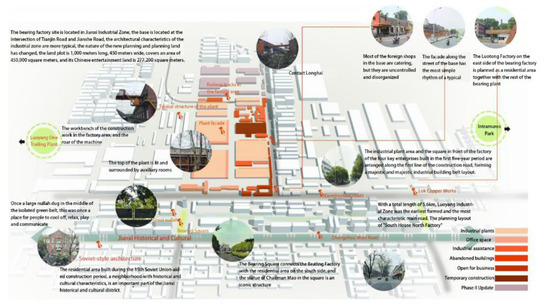
Figure 6.
The current Luoyang Bearing industrial of remains.
In architectural design, the educing energy design method combining overall preservation (that is, the overall preservation of the structural system, the envelope structure and the carrier reflecting the characteristics of context memory) or partial preservation (that is, with the preservation of the structural system, the envelope structure can be partially reformed and the scenery without context value can be dismantled) and internal space subdivision organization should be adopted. In the way of reserving pieces to form a sheet of the overall system display, a low-carbon environment and energy savings can be achieved. Finally, through landscape implantation and the intelligent reuse of space, a landscape node combining industrial landscape elements and modern landscape design is created to realize energy savings and intelligence.
6.1. The Planning of Educing Energy and Smart
In the planning process, energy saving is combined with collective cultural memory, and a landscape axis with industrial characteristics is constructed along the north–south main road by utilizing the elements of the factory, connecting each landscape node in the factory. At the south entrance of the entrance square, the themed sculpture reflecting the industrial glory period is placed, which is planned as the entrance sculpture square, highlighting the industrial culture. By setting up air corridors with industrial characteristics and constructing landscape nodes with structures, the central part of the factory is transformed into a themed area of space corridors, which is an important landscape node in the factory (Figure 7).
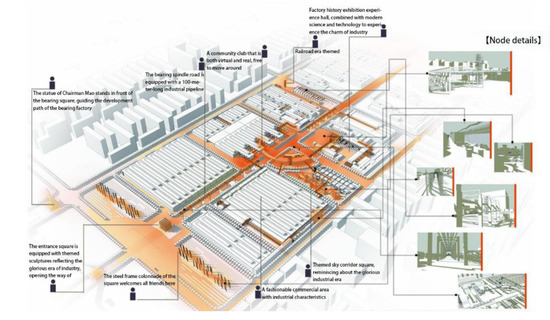
Figure 7.
Plant landscape axis and landscape node diagram.
At the same time, the typical pipeline elements of the factory are used to transform them into distinctive sunshades, rest chairs, flower beds, etc. The abandoned rail in the factory is transformed into the themed landscape square in the railway era, which becomes the landscape node displaying industrial culture in the factory. The most used element in the factory is the supporting structure of the workshop (Figure 8). Light steel is used to build the framework of the supporting structure of the workshop, which is used to connect, enclose and guide, and it reflects the sense of industrial heavy metal and carries out a digital intelligent virtual display.
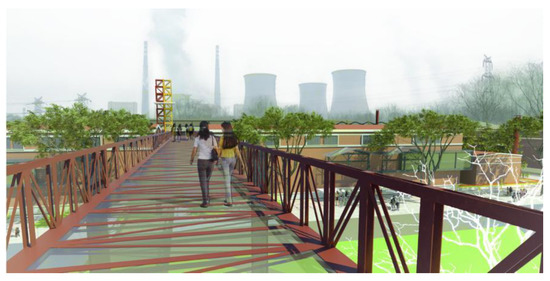
Figure 8.
The air corridor transformed with waste iron to save energy.
6.2. The Building of Educing Energy and Smart
In the reconstruction of the mass innovation office area, we follow the principle of industrial heritage authenticity and energy conservation. Therefore, there is less reconstruction of the building facade. The external wall of the workshop has ivy, Not only beautiful but also insulated, and it forms a natural landscape (Figure 9).
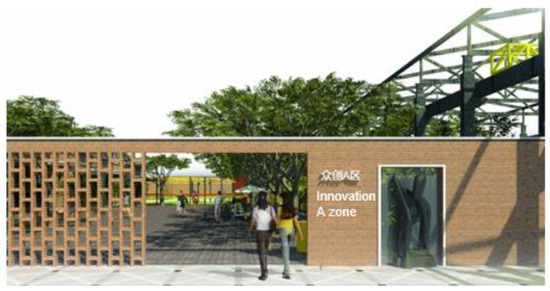
Figure 9.
Partial renderings of the factory Exhibition Experience hall.
Through addition and construction, the original unrelated monomer is connected, and on the basis of respecting the original texture, a workshop is added, which is consistent with the style of the original building workshop, forming a sequence. The workshops are connected with glass box connecters, and the modern sense and the sense of The Times are well-combined, generating a strong impact of the new and the old. While energy saving, it embodies a symbiosis between the old and the new (Figure 10).

Figure 10.
Section A1-1 of innovation A zone.
7. Renewal Path of Old Industrial Zone in Jianxi District
A survey of residents in Jianxi District shows that although the interviewees have formed a collective memory of the material memory field and spiritual memory field of Jianxi, they are more likely to have visual or palpable material memory (average familiarity of 3.68). Compared with the spiritual level of memory, the Chairman Mao Sculpture and Xiyuan Road in front of the tractor factory are the most familiar in the material memory field. The Soviet Union-aided Construction of the 156 projects is the most familiar in the mental memory field. Therefore, the renewal protection design based on collective memory needs to continue the high memory part of the residents, strengthen the low memory part and combine the material memory field with the spiritual memory field to create a characteristic humanistic space. The future study of collective memory planning can be carried out from the following aspects.
7.1. Physical Memory Field Level
If the conditions at the regional level are mature, the Jianxi “World Industrial Heritage area” with the characteristics of the “Luoyang Model” will be formed. Zhongzhou Road takes the construction road connecting the production space and living space as the main axis of industrial heritage. In the production space, the statue of Chairman Mao with the highest memory is taken as the leading core, the function of the production space is replaced, the overall mechanism of the factory remains unchanged, the local volume ratio is improved and the renewal mode of land efficiency is increased. The order of memory is the neighborhoods No. 2, No. 10 and No. 11 of the older generation revolutionaries and Soviet experts in the living space, and the renewal strategy of the production space is the combination of the core protection of the important nodes and the coordinated transformation of other living spaces. The spiritual memory of “Shanghai Market and Guangzhou Market” is high and the architectural features are not obvious, so it is suggested that the local name should be retained; the scientific research space can be updated without protection; and the construction of Xiyuan Road and Jian River with high memory in the landscape space should be highlighted. Xiyuan Road is the “leisure secondary axis” and Jian River is the “industrial embroidery belt”. Jianshe Road Industrial heritage axis, Xiyuan Road landscape axis and Jianhe Industrial embroidery Belt: That is, “two axes one belt” in series, Series “beads” to integrate the overall memory elements.
7.2. Mental Memory Field Level
Relative to the physical memory field, the average degree of familiarity with this memory is 2.7, and the overall familiarity with the mental memory field is relatively low (1.8). Ten should also be related to the objective existence of material visibility. In terms of cultural names, the highest is the “156” projects. Government departments regularly hold seminars on the “156” projects, with high familiarity in the interviewed memory, so as to form a brand culture and improve the memory of cultural names. The aim is to carry forward the red industrial spirit. In terms of social perception, the formation of industrial spirit and industrial culture is inseparable from the “people” behind the heritage entity. It is suggested that the deeds of hard struggle, patriotism and the dedication of “old workers” and “local people” such as Zhongxun Xi and Yulu Jiao should be deeply mined in social perception. At the same time, it is also necessary to record important historical situations, such as pictures and written materials of veteran factory workers, the oral history of old factory workers and so on. Aim to reproduce the collective memory of local important people and groups. The important event with the highest memory of the birth of China’s first tractor is the concentrated embodiment of the achievements of that era and the enterprise spirit of “self-reliance and hard struggle”. Important events have greatly enhanced national self-confidence. Seek to convey the spiritual connotation of the place and tell a good Jianxi story. Form influential and regularly held well-known cultural festivals with characteristics.
7.3. Update Path
Adhere to the principle that utilization is protection and refuse frozen protection. The material memory field and spiritual memory field integrate and promote each other, and they promote regional local identity.
7.3.1. Physical Memory Field
In the industrial production area, the first tractor factory, bearing factory, mine machinery factory and copper processing plant which are of great significance and outstanding value will be designated as the core area of industrial heritage, and if the conditions are ripe, they will be declared as the corresponding level of cultural protection units as soon as possible. In the general survey, we should focus on the mine machinery factory and other factories with relocation and transformation plans and do a good job of recording material memory resources, such as characteristic buildings and precious industrial equipment. Strengthen the attention of the community in these industrial production areas, in view of the general situation of economic recession and laid-off unemployment in the post-industrial period, by changing the dilapidated residential environment, preserving the “life circle” and combining Luoyang to create a “capital of oriental museums”. Establish and improve the industrial heritage museum system combined with the factory area to inherit the regional culture to form the “community heritage” of the enterprise compound.
7.3.2. Mental Memory Field
Actively carry out the general survey and value identification of the “156 projects” in Luoyang, establish the information database of Jianxi industrial heritage and seize the opportunity to actively carry out the identification and application of national industrial heritage. Intangible memory resources such as industrial culture and spirit should be registered. At the same time, strengthen public participation, collect residents’ suggestions, pay attention to collective memory and extensively absorb the opinions of all parties in the formulation of the industrial base transformation plan. In terms of industry, it is necessary to give full play to the role of cultural cohesion, expand new ways of industrial tourism, change the simple mode of sightseeing education, integrate into the immersion experience and adapt to the development of new media, such as film, television, Internet, music and so on. The use of a simulacra world, community imagination [18] propaganda: the use of multiple media to improve public awareness of a series of special interviews and reports on urban historical protection. Great exposure can raise public awareness of the importance of industrial heritage. Make full use of the convenience of the network and the self-media platform; tap the breadth and depth of the industrial culture of the “156 projects”; add voice explanation and interaction by means of wechat soft text push, online drawing images, location check-in pictures, etc.; update different topics every day, involving various contents such as the industrial evolution, factory history, technological process, etc.; and integrate the fragmented information of industrial culture into science and technology, creativity, art and other forms. This will allow to create a medium for inheriting industrial culture that adapts to the contemporary demands of diversity.
8. Conclusions and Discussion
Place is a space full of emotion and memory, and collective memory is the basis for identifying local characteristics and promoting local identity to retain nostalgia. Through the collective memory theory system, this paper analyzes the two major memory fields of matter and spirit, including 11 space types and 76 memory connotations in the old industrial base, and analyzes the memory degree of the residents by way of a questionnaire. It is found that (1) the collective production space is the most impressive, (2) the living space is patched by the effect of celebrities and (3) the symbolization of collective memory is more prominent. From the point of view of protecting and inheriting the industrial culture, this paper puts forward a renewal strategy and protection planning to promote the revitalization of the old industrial base, the future urban construction advocates individuality and characteristics, and the protection and reuse of industrial relics will also be adapted to local conditions. Mining industrial culture with its own characteristics, we can appropriately deepen and expand the research scope in the future and compare the decision makers, stakeholders, construction intensity and economic aspects of the old industrial area. It is expected to provide a beneficial exploration of the renewal of “promoting industrial transformation by cultural revival”, as well as the path of urban design and the transformation of old industrial areas. It provides a reference for the protection of collective memory and the construction of urban culture.
Author Contributions
F.Y. and L.Z.; methodology, F.Y.; software, F.Y.; validation, F.Y.; writing—original draft preparation, L.Z.; writing—review and editing, All authors have read and agreed to the published version of the manuscript.
Funding
Basic Research Projects of Key Scientific Research Projects Plan in Henan Higher Education Institutions (20zx003), Henan Natural Science Foundation (222300420579). 2020NSFC Planning and measurement method of optimal allocation of urban construction land (52078405).
Institutional Review Board Statement
Not applicable.
Informed Consent Statement
Not applicable.
Data Availability Statement
Not applicable.
Conflicts of Interest
The authors declare no conflict of interest.
References
- Xi, J. Win a Decisive Victory in Building a Moderately Prosperous Society in an All-Round Way and Win the Great Victory of Socialism with Chinese Characteristics in the New Era: A Report at the 19th National Congress of the Communist Party of China. Available online: http://www.gov.cn/zhuanti/2017-10/27/content_5234876.htm (accessed on 31 December 2017).
- Assmann, J. Religion and Cultural Memory; Stanford University Press: Stanford, CA, USA, 2006. [Google Scholar]
- Rousso, H.; Syndrome, V. History and Memory in France; Harvard University Press: Cambridge, MA, USA, 1991. [Google Scholar]
- Vernon, P. Greek Myth and Thought—A Study of Historical Psychoanalysis; Huang, Y., Translator; Renmin University of China Press: Beijing, China, 2007. [Google Scholar]
- Derick, F.; Dreher, W. The art historian as Simonides: The importance of antique memory in the art library, from Warburg to the present. Mem. Oblivion 1999, 10, 57–62. [Google Scholar]
- Habtuohe, M. On Collective Memory; Bi, R.; Guo, J., Translators; Shanghai People’s Publishing House: Shanghai, China, 2002. [Google Scholar]
- Withers, C.W.J. Landscape, memory, history: Gloomy memories and the 19th century Scottish Highlands. Scott. Geogr. J. 2005, 121, 30–41. [Google Scholar] [CrossRef]
- MacCannell, D. The Tourist: A New Theory of the Leisure Class; University of California Press: Berkeley, CA, USA, 1999. [Google Scholar]
- Mumford, L. The City in History: Its Origins, Its Transformations and Its Prosects; Harvest Books: New York, NY, USA, 1961. [Google Scholar]
- Lynch, K. Urban Intention; Fang, Y.; He, X., Translators; Huaxia Press: Beijing, China, 2001. [Google Scholar]
- Rossi, A. Urban Architecture; Huang, S., Translator; China Building Industry Press: Beijing, China, 2006. [Google Scholar]
- Chang, Q. Past Future: Critical Cognition and Practice of Built Heritage. J. Archit. 2018. [Google Scholar] [CrossRef]
- Wang, J. Inclusive sharing, mutual learning, livable and sustainable. Urban Plan. 2019, 43, 201. [Google Scholar]
- Lu, J.; Wang, Y. Construction of Characteristic Vitality Areas. Urban Planing Forum 2016, 6, 8. [Google Scholar]
- Huang, M.; Wang, Y. Time: Looking for Lost Beauty; Urban Development Research: Beijing, China, 2019. [Google Scholar]
- Xu, S. Paying Attention to "Memory". Urban Archit. 2019, 16, 2–3. [Google Scholar]
- Lv, F.; Wu, H. Remains, Memories and Regeneration: Exploration of Material Remains and Renewal Paths of “156 Projects” in Harbin. Urban Dev. Res. 2018, 25, 80–87. [Google Scholar]
- Zhou, W. Spatial Traceability of Traditional Cultural Tourist Destinations Based on Urban Memory; Regional Research and Development: Beijing, China, 2016. [Google Scholar]
- Huang, X. Cultural memory. Foreign Theor. Trends 2006, 6, 11. [Google Scholar]
- Kong, X.; Zhuo, F. The influence of cultural landscape on the construction of local collective memory-take Chengkan ancient village in Huizhou as an example. Geogr. Sci. 2017, 37, 110–117. [Google Scholar]
- Wang, Y.; Han, L. The models of traditional culture landscape conservation based on landscape isolation analysis: A case study on Luzhi Town in Jiangsu Province. Geogr. Res. 2014, 33, 143–156. [Google Scholar]
- Huang, W.; Liang, L.; Li, F. Review of Western Memory Geography Research from the Perspective of Text, Conflict and Performance. Hum. Geogr. 2016, 31, 17–25. [Google Scholar]
- Li, J. Research on the Connotation and Construction Path of Urban Memory. Master’s Thesis, Shanghai Normal University, Shanghai, China, 2019. [Google Scholar]
- Sun, Y. Historical Research and Value Analysis of Luoyang 156 Industrial Heritage Group. Ph.D. Thesis, Tianjin University, Tianjin, China, July 2016. [Google Scholar]
- Xu, S.; Sun, Y. From industrial heritage to urban heritage-Analysis of material composition of industrial heritage in Luoyang in 156. Res. Urban Dev. 2015, 8, 112–117. [Google Scholar]
- Archives of China Urban Planning and Design Institute. Summary of Luoyang City Planning Data/Comprehensive Information of Luoyang City Planning; CaseNo.: 0829:16; Archives of China Urban Planning and Design Institute: Beijing, China, Unpublished work.
- Dong, Z.; Wu, J. The Cornerstone of New China’s Industry-156 Construction Studies; Guangdong Economic Press: Guangzhou, China, 2004. [Google Scholar]
- Li, H. Eight Key Urban Planning-A Historical Study of Urban Planning in the Early Period of New China, 2nd ed.; China Building Industry Press: Beijing, China, 2019. [Google Scholar]
- Archives of China Urban Planning and Design Institute. Luoyang Jianxi District Master Plan (October 25, 1954); CaseNo.: 0834.7; Archives of China Urban Planning and Design Institute: Beijing, China, Unpublished work.
- Haichao Publishing House. Luoyang Jianxi Local Records Compilation Committee. Luoyang Jianxi District Local Records; Haichao Publishing House: Beijing, China, 1990. [Google Scholar]
- Luoyang First Tractor Factory. Luoyang First Tractor Factory. Internal Issue; Luoyang First Tractor Factory: Luoyang, China, 1986. [Google Scholar]
- Compilation Committee of Luoyang Bearing Factory. Luoyang Ball Bearing Factory. Internal Issue; Compilation Committee of Luoyang Bearing Factory: Luoyang, China, 1986. [Google Scholar]
- Compilation Committee of Luoyang Copper Processing Factory. Luoyang Copper Processing Factory. Internal Issue.; Compilation Committee of Luoyang Copper Processing Factory: Luoyang, China, 1986. [Google Scholar]
- Compilation Committee of Luoyang Mining Machinery Factory Records. Luoyang Mining Machinery Factory Records. Internal Issue; Compilation Committee of Luoyang Mining Machinery Factory Records: Luoyang, China, 1986. [Google Scholar]
- Brusaporci, S.; Maiezza, P. Smart Architectural and Urban Heritage: An Applied Reflection. Heritage 2021, 4, 2044–2053. [Google Scholar] [CrossRef]
- Lucchi, E. Integration between photovoltaic systems and cultural heritage: A socio-technical comparison of international policies, design criteria, applications, and innovation developments. Energy Policy 2022, 171, 113303. [Google Scholar] [CrossRef]
- Li, W.; Qi, J.; Kai, Z. Spatial identification and pattern evolution of cultural memory in Gansu Province. Econ. Geogr. 2021, 41. [Google Scholar] [CrossRef]
Disclaimer/Publisher’s Note: The statements, opinions and data contained in all publications are solely those of the individual author(s) and contributor(s) and not of MDPI and/or the editor(s). MDPI and/or the editor(s) disclaim responsibility for any injury to people or property resulting from any ideas, methods, instructions or products referred to in the content. |
© 2023 by the authors. Licensee MDPI, Basel, Switzerland. This article is an open access article distributed under the terms and conditions of the Creative Commons Attribution (CC BY) license (https://creativecommons.org/licenses/by/4.0/).